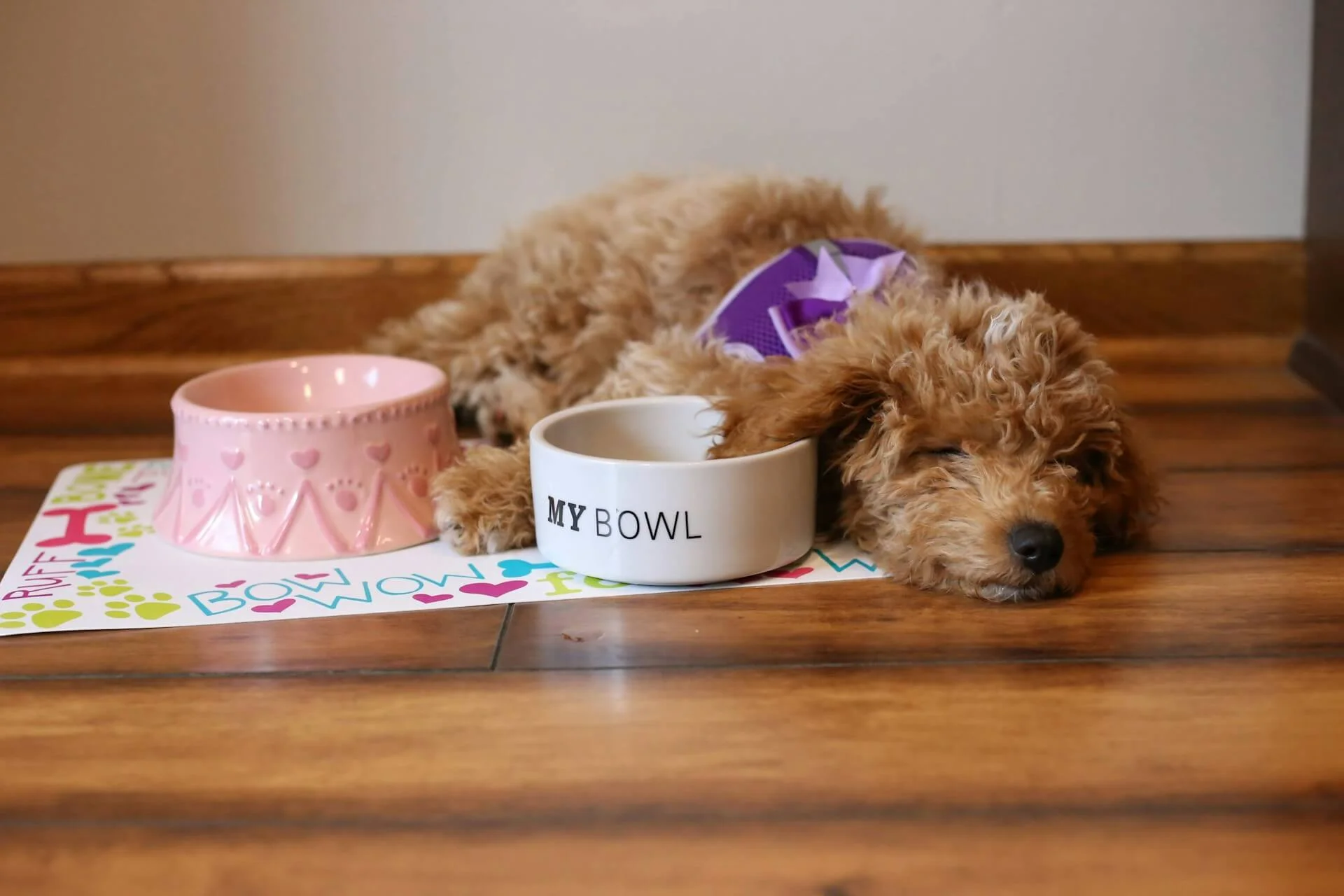Table of Contents:
- Nutrition Needs for Mini Goldendoodle Puppies
- Choosing Food Types & Ingredients
- How Much & How Often to Feed
- Managing Allergies, Sensitive Stomachs & Skin/Coat Health
- Safety, Quality, & Label Reading
- Homemade, Raw & Alternative Diets: Risks & Best Practices
- Troubleshooting & Transitioning Between Foods
- Final Thoughts
- FAQ
Mini Goldendoodles are energetic, affectionate, and fast-growing companions. Their nutrition during puppyhood shapes their lifelong health — supporting bone development, immune strength, and their famously fluffy coat. But with so many options on the market, how do you choose the best puppy food for a Mini Goldendoodle?
This guide breaks down nutritional needs, food formats, feeding schedules, common health concerns, and safe practices.

Nutrition Needs for Mini Goldendoodle Puppies
Feeding a puppy isn’t just about filling the bowl — it’s about matching nutrition to growth stages and breed-specific needs. Mini Goldendoodles develop quickly, so understanding their unique requirements will help you choose the right formula.
What Growth Stages Affect Nutritional Requirements
From 8 weeks until about 12–18 months, a Mini Goldendoodle is in a rapid growth phase. Puppies require higher levels of protein, fat, and essential minerals than adults. Unlike standard Goldendoodles, miniatures usually fall between 15–35 pounds as adults, making them closer to small-to-medium breeds.
At 8–12 weeks, growth is particularly fast. A puppy at this age needs frequent meals and calorie-dense puppy food for Mini Goldendoodles. Between 3–6 months, growth steadies but skeletal development is still critical — this is where maintaining the right calcium-to-phosphorus ratio matters. From 6–12 months, energy needs are high, but portion control becomes important to prevent excess weight gain.
Essential Nutrients: Protein, Fats, Vitamins, Minerals, DHA
The best puppy food Mini Goldendoodle contains:
- Protein (22–30%). Supports muscle and organ growth. Animal-based proteins like chicken, turkey, salmon, or lamb are most digestible.
- Fats (8–15%). Fuel growth and maintain energy. Healthy fats, especially omega-3 fatty acids, support brain development and a shiny coat.
- Carbohydrates. Digestible carbs from rice, oats, or sweet potato provide fiber and steady energy.
- Calcium & phosphorus. Promote strong bones. For Mini Goldendoodles, avoid excess calcium (not a large-breed puppy), but ensure it meets AAFCO puppy standards.
- DHA (an omega-3). Enhances cognitive and vision development.
A complete and balanced puppy food for Mini Goldendoodles ensures these nutrients are present in the right proportions.

Choosing Food Types & Ingredients
Not all puppy foods are created equal. Kibble, wet, fresh, or raw each offer benefits and challenges, and the right choice often depends on your dog’s preferences, sensitivities, and your lifestyle.
Kibble vs Wet vs Fresh / Freeze-Dried / Raw
Owners often wonder if the best dog food for Mini Goldendoodle puppies should be kibble, wet, or fresh.
- Dry kibble. Convenient, cost-effective, and supports dental health. Look for small-bite or “mini breed” formulas.
- Wet food: Higher moisture content, great for picky eaters, but pricier and perishable.
- Fresh-cooked / subscription foods. Balanced and minimally processed, often tailored by weight and age.
- Freeze-dried / air-dried. Nutrient-rich and lightweight, but expensive.
- Raw diets. Popular with some owners, but require strict hygiene and supplementation to avoid nutritional deficiencies.
The FDA warns that raw feeding carries risks of bacterial contamination if not handled properly.
Grain-Inclusive vs Grain-Free & Novel Protein Options
Grain-free diets surged in popularity but are not necessary unless your puppy shows intolerance. Most Mini Goldendoodles do well on whole-grain formulas with rice, oats, or barley. Grain-free diets should be approached cautiously due to ongoing research into potential links with heart disease (FDA report).
Novel proteins like duck, venison, or fish can help if your puppy has chicken sensitivity. A limited-ingredient food for Mini Goldendoodle puppies is useful in allergy management.
Small-Kibble / Bite-Sized Formulas Suited for Mini Breeds
Mini Goldendoodles often have smaller jaws inherited from the Poodle side. Bite-sized kibble is easier to chew and digest. Choose products labeled for “small breed puppies” or “mini breed formulas” for safety and comfort.

How Much & How Often to Feed
Knowing what to feed is only half the picture — you also need to understand how much and how often. Proper portioning ensures your puppy grows steadily without gaining excess weight.
Portion Sizes & Calories by Age & Weight
The amount of food per day for Mini Goldendoodle puppies depends on age, weight, and activity. Instead of memorizing fixed numbers, veterinarians recommend using formulas:
- RER (Resting Energy Requirement) = 70 × (BWkg^0.75)
- MER (Daily Calories) =
- Puppies under 4 months: ~3 × RER
- Puppies 4 months and older: ~2 × RER
Examples:
- A 10-lb (4.5 kg) puppy at 3 months: RER ≈ 216 kcal → ~650 kcal/day.
- A 15-lb (6.8 kg) puppy at 6 months: RER ≈ 301 kcal → ~600 kcal/day.
Check the feeding chart on your chosen puppy food package and adjust portions weekly based on growth, body condition, and stool quality.
WSAVA Global Nutrition Guidelines recommend energy calculations and adjusting portions with body condition scoring.
Meal Frequency: From Weaning to Adulthood
- 8–12 weeks: 4 meals/day
- 3–6 months: 3 meals/day
- 6–12 months: 2–3 meals/day
- 12 months+: 2 meals/day
American Kennel Club recommends smaller, more frequent meals in young puppies to avoid hypoglycemia.
Managing Allergies, Sensitive Stomachs & Skin/Coat Health
Mini Goldendoodles are prone to digestive issues and skin sensitivities. Paying attention to ingredients and supportive nutrients can help prevent common problems.
Recognizing & Avoiding Common Allergens
Mini Goldendoodles are prone to food sensitivities — commonly chicken, beef, or certain grains. Symptoms include chronic diarrhea, itchy skin, or recurring ear infections. If suspected, try a novel protein or limited-ingredient puppy food for Mini Goldendoodles under vet supervision.
Ingredients & Add-ons That Support Skin & Coat
Supplements or foods rich in fish oil (omega-3), flaxseed, and probiotics help keep the doodle coat glossy and skin healthy.
Safety, Quality, & Label Reading
What “Complete & Balanced for Growth” Means
When evaluating puppy food for Mini Goldendoodles, check for the AAFCO nutritional adequacy statement:
- “Complete and balanced nutrition for growth” indicates suitability.
- “All life stages including growth” also qualifies, provided it meets puppy requirements.
How to Evaluate Manufacturer, Recalls, Ingredient Transparency
Choose brands that:
- Publish full nutrient profiles, not just minimums.
- Use named animal proteins (“chicken meal” vs. “meat by-product”).
- Have clean recall histories (AVMA Recall Database).
Safe Handling & Storage, Especially for Wet / Raw / Fresh Foods
- Store kibble in airtight bins away from sunlight.
- Refrigerate opened wet/fresh food within 2 hours.
- Discard uneaten raw food immediately.

Homemade, Raw & Alternative Diets: Risks & Best Practices
Some owners prefer alternative feeding methods like homemade or raw diets. While these can be appealing, they come with important risks and require careful planning.
Pros and Cons of Homemade or Raw Diet for a Growing Mini Goldendoodle
Some owners prefer homemade or raw diets. While they can be appealing, they are difficult to balance. A study found most homemade recipes lacked essential nutrients when not formulated by a veterinary nutritionist.
Essential Supplementation and Vet Guidance
If you choose a homemade or raw path, work with a board-certified veterinary nutritionist. Supplements such as calcium, taurine, and essential vitamins must be added. This ensures your chosen food for a Mini Goldendoodle puppy supports safe growth.
Troubleshooting & Transitioning Between Foods
Even with the best planning, issues like refusal to eat or stomach upset can happen. A careful transition and quick troubleshooting can save stress for both you and your puppy.
How to Switch Foods Safely (Transition Plan)
When switching brands or food types, use a gradual 7–10 day process:
- Days 1–3: 25% new, 75% old
- Days 4–6: 50% new, 50% old
- Days 7–9: 75% new, 25% old
- Day 10: 100% new
What to Do If Puppy Refuses Food or Has Digestive Upset
Refusal to eat can stem from stress, teething, or palatability issues. Try warming food slightly, adding a spoonful of wet food, or using puzzle feeders. If diarrhea or vomiting persists beyond 24 hours, consult a vet — don’t keep switching foods too quickly.
Final Thoughts
Feeding your Mini Goldendoodle puppy well is one of the most impactful decisions you’ll make. With the right nutrient balance, format, and feeding schedule, you’ll set the foundation for a healthy, energetic, and happy dog.
FAQ
What is the best food for a Mini Goldendoodle puppy?
The best food for a Mini Goldendoodle puppy is one that meets AAFCO growth standards, contains high-quality protein, balanced fats, and DHA, and is appropriate for small-to-medium breed puppies. Kibble, wet, or fresh options can all work.
How much should I feed my Mini Goldendoodle each day?
The amount of food per day for Mini Goldendoodle puppies varies by age and weight. At 3 months, a 10-lb pup may need ~650 kcal daily, while at 6 months and 15 lb, ~600 kcal.
Should my puppy eat grain-free food?
Not necessarily. Unless allergies are confirmed, most puppies thrive on grain-inclusive diets. Grain-free foods should be used cautiously, as the FDA continues to study potential heart health concerns.
Can I make homemade food for my puppy?
Yes, but only with guidance from a veterinary nutritionist. Homemade recipes often lack essential nutrients unless supplemented properly.
When should I switch from puppy to adult food?
Mini Goldendoodles usually transition to adult food at 12–14 months, when they reach 90% of adult size. Consult your vet for tailored guidance.




